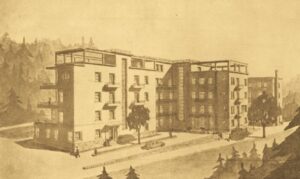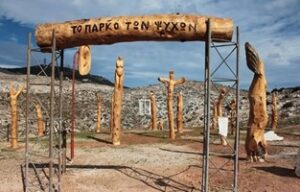Evangelia Mourellou, Dimitra Bartzi, Gregory Tsoucalas
Department of the History of Medicine and Medical Deontology, School of Medicine, University of Crete, Heraklion, Greece.
Dear Editor,
The former Parnitha Sanatorium, now in ruins, was located on Mount Parnitha in the Municipality of Acharnon in the outskirts of the city of Athens. It was in 1914 when the Monastery of Petraki donated a piece of land to the “Evangelismos Hospital” of Athens to establish a sanatorium for the care of tuberculosis patients, as the disease was rampant at that time, causing numerous deaths [1]. The favorable climate of the Parnitha mountain due to its altitude was considered ideal for the treatment of patients. Clean air, forest environment and modern facilities rendered sanatorium to a place of hope [2]. It was established after the early death of Konstantinos Foug, who succumbed to tuberculosis, as he honored the wishes of his late mother, Fainareti Ervert, and the memory of his father, Georgios Foug, after the tragedy that was faced by the Foug family. Fainareti Ervert was the niece of the founder of the National Bank of Greece Georgios Stavrou. After Fainareti lost both her husband and her eldest son, she stated in her will that, should her surviving son die without heirs, the entirety of their estate would be used for the establishment of a sanatorium for tuberculosis patients, under the name “Georgios Stavrou and Georgios Foug” [3] Among the many inmates, the famous poet Yiannis Ritsos was admitted to the sanatorium. Ritsos was infected with tuberculosis and suffered from hemoptysis since 1926, while he had been hospitalized in Parnitha Sanatoriun between 1937 and 1938. There, Ritsos wrote his poem “Spring Symphony” [4-5]. Parnitha Sanatorium consisted of five floors and an elevated basement, a design by the architect Ioannis Antoniadis (1890-1977), starting its operations in August 1936 [Figure 1]. However, its first inauguration during August 1914 marked the beginning of the efforts of the families of Georgiou Staurou and Georgiou Fougk, who left their fortunes to establish a tuberculosis sanatorium.
Figure 1. Parnitha Sanatorium, a design by the architect Ioannis Antoniadis, 1936. |
The original hospital of 1914 was simply a wooden pavilion. The 1936 Parnitha Sanatorium used all modern techniques of the era, such as the iron lungs to treat the more than 100.000 ill all around Greece [6]. With the discovery of penicillin in 1943 and the gradual abandonment of sanatoriums, Parnitha Sanatorium closed in 1960. A few years later, it was converted into a hotel named “Xenia” and was also used as a school for tourism professions, until 1984, when its final abandonment was announced [Figure 2].
Figure 2. The renovated entrance of the Xenia Hotel with the stairs added to create a lobby. |
In 1999, after an earthquake centered in Parnitha, the building was deemed unsuitable for visitation. However, not only did visitors continue arriving, but there were also numerous looting incidents of its equipment and records. Finally, in July 2022, it was declared a “preserved” building by the Hellenic Ministry of Environment and Energy [7]. The abandoned appearance of the building, combined with the care of tuberculosis patients and the numerous deaths that occurred while it operated as a sanatorium, have led to the creation of urban legends around it. Many people believe it is haunted, claiming to have felt supernatural entities and heard eerie screams. As a result, it continues to attract crowds wishing to verify these claims. Meanwhile, a few meters away is located the “Park of Souls”, an outdoor museum created in 2012 by sculptor Spyridon Dassiotis, consisting of exhibits that represent human figures made from tree trunks, evoking awe in visitors [Figure 3] [8].
Figure 3. The Park of Souls in Parnitha near sanatorium. |
References
1. Papaioannou Ath. In memory of Athens: Athens, Piraeus and the suburbs at the beginning of our century. Gnosi, Athens, 2011.
2. Forest Chronicles. Parnitha Sanatorium. Panhellenic Federation of Foresters’ Associations, Athens, 1958.
3. Skiadas G. The “haunted” Sanatorium of Parnitha “G. Stavrou and G. Fugh Hospital”. Athenaika, Athens, 2020.
4. Ritsos Y. Ritsos in Parentheses. Princeton University, Princeton, 1979.
5. Prevelakis P. The poet Yiannis Ritsos, the overall view of his work. Estia, Athens, 1992.
6. Tsilivis K. Parniths Parnitha Sanatorium & The architecture of the Sanatoria of the 1930s. Thesis. AKTO, Athens, 2015.
7. Lalios G. Preserved building, the historic
sanatorium in Parnitha. Kathimerini, Athens, 2022.
8. Xanthos Ath. Parnitha Sanatorium: What do you know about the “park of souls” in Athens Athens Now, Athens, 2024.



